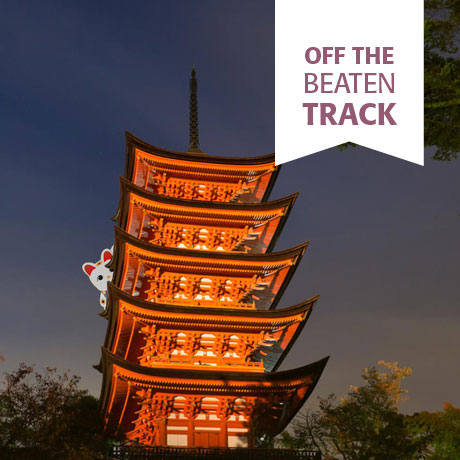Samurai and "the way of the warrior"
For those interested in Japanese history, samurai culture and the role this military class played in shaping Japan is a fascinating one.
Although samurai no longer exist, the influence of these great warriors still manifests itself deeply in Japanese culture and samurai heritage can be seen all over Japan - be it a great castle, a carefully planned garden, or beautifully preserved samurai residences. It is also deeply ingrained in the psyche of the Japanese people.
The basis of samurai conduct is bushido, "the way of the warrior". This unique philosophy valued honour, reckless bravery and selflessness, as well as duty to the warrior's master with the purpose of giving up one's life and embracing death. There was no place for fear in the way of the warrior and this conduct of self discipline and respectful, ethical behaviour was to become the role model behaviour for other classes throughout Japan's history.
Samurai: Highly literate men of war and leadership
Not only were the samurai skilful warriors, but they were also expected to be highly cultured and literate; to be skilled in the harmony of fighting and learning. An ancient saying aspired to by warriors was bun bu ryo do: "the pen and sword in accord", and it was common for samurai to enjoy calligraphy, tea ceremony, poetry and music, and to study.
It was these highly aspired ideals of educated warriors that allowed for the cohesion of samurai armies and for their power to eventually dominate government. In 1160, the Taira clan beat the Minamoto clan and Taira no Kiyomori established the first samurai-lead government with the emperor losing control and being relegated to figurehead status.
Up until that time, throughout the Heian Period (794-1185), samurai had been employed to serve in close attendance with nobility, protecting the land of the wealthy: aided by political backing and resources the samurai had come into political power. Taira's control did not last long though as in 1192, at the start of the Kamakura Period (1192-1333), Minamoto Yorimoto received the title of shogun and gained rule of Japan.
Various bakufu or shogunate ruled over the centuries, each shaping the leadership of the country in their own way with the samurai continuously influencing the classes with their ideals of high literacy and education. Such was the influence of these elite warriors that during the Edo period (1603 - 1868) levels of literacy were higher than that of central Europe.
The calm mind of a samurai warrior
From the thirteenth century, samurai conduct became heavily influenced by Zen Buddhism.
By being present in the moment, Zen training allowed a samurai to become one with their sword and the free and spontaneous mind gave them the mental edge over their enemy. Zen meditation calmed the mind and gave a warrior philosophical strength to deal with their inevitable death.
Zen complemented and influenced the way of the warrior and over four centuries Zen practices, such tea ceremony, monochrome ink painting, rock gardens, and poetry (haiku) introduced by monks were allowed to flourish thanks to these great warriors. Buddhist teachings had such an immense effect that as they became more ingrained in samurai life some samurai lost meaning in killing and gave up their sword for lives as monks.
Samurai and the sword
Synonymous with samurai bravery is the katana, or samurai sword, and bushido dictated that this curved, slender blade was the soul of a warrior. Images of samurai depict them with their masterfully crafted weapons of war and together with the shorter blade of a wakizashi, this pair, known as the daisho, represented the social status and personal honour of the samurai.
In the mid-1600s, Miyamoto Musashi, the highly revered and undefeated swordsman and samurai, wrote Go Rin Sho, or The Book of Five Rings. Widely published today, his teachings on military strategy and tactics draw heavily on Tibetan and Zen philosophy and he advocated the use of both the katana and the wakizashi simultaneously in battle.
During the Edo period the Tokugawa shogunate sought to achieve a unified Japan and towards the end of this relatively peaceful time the role of the samurai changed from that of warrior to courtier, bureaucrat and administrator, and with it the original use of the katana. Although they continued to carry their swords they were now more a symbol of power rather than a means of defence.
Not only master swordsmen, samurai were also proficient in using the yumi, or longbow. When the longbow ceased to be used as a weapon the art of kyujutsu, the skill of the bow, was adapted to a sporting activity. Yabusame, the practice of shooting from horseback, was introduced into Shinto ceremonies and this form of archery can still be enjoyed today in certain festivals throughout Japan.
Decline of the warrior
The decline of the samurai came in the late nineteenth century as Japan opened its borders to the US navy and the power was given back to the imperial family in the Meiji Restoration in 1868. Samurai became known as shizoku, a term which represented their former samurai status, and they were no longer allowed to wear a katana in public.
In the late nineteenth century the samurai class was abolished in favour of a western-style national army, and as a result many of the samurai became highly motivated and disciplined Imperial Army Officers or used their high levels of literacy to become reporters, writers or to serve in government.
Samurai heritage
Japan is proud of its warriors of the past and the way of the warrior can be found all over this beautiful country, be it visiting one the great castles that bore witness to many a bloody battle, experiencing a festival with its origins in samurai culture; visiting the grounds of great samurai battles in history or a pilgrimage to the small cave where Musashi wrote The Book of Five Rings.
Samurai ideals have transcended throughout Japanese history and understanding the samurai heritage provides an interesting insight into today's modern society and the respect, discipline and honour that is prevalent throughout this unique nation and that the rest of the world admires.
Discover the enduring legacy of the samurai and experience the rich tapestry of respect, discipline, and honour that defines Japan. Embark on one of our exclusive tours of Japan to explore this unique nation's historical sites and modern marvels, and see for yourself why the world admires it's remarkable culture.
Featured trips
-
Small Group Tour
Hidden Japan (IJT Classic)
- Kyoto
- Mount Koya
- Tokushima
- Takamatsu
- Kotohira
- Matsuyama
- Hiroshima
- Kyoto
Discover the road less travelled
12 nights: AU$10448 Read more >
-
Self-Guided Adventure
Pilgrim's Paths (Classic)
- Tokyo
- Kyoto
- Mount Koya
- Kawayu Onsen
- Yunomine Onsen
- Nachi
- Ise
- Tokyo
Join the ranks of the junreisha, or pilgrims, as you explore Ise, Mount Koya and the ancient paths of the Kumano Kodo on this classic trip.
14 nights: from AU$7791 pp (twin share) Read more >
-
Self-Guided Adventure
Traditional Japan (Classic)
- Tokyo
- Kanazawa
- Shirakawago
- Takayama
- Matsumoto
- Tsumago
- Kyoto
- Tokyo
A classic 14-night adventure introducing the traditional side of Japan, from Japanese-style inns to time-honoured cuisine and ancient temples.
14 nights: from AU$7938 pp (twin share) Read more >
 UK
UK
 USA
USA





 Inside Japan UK office
Inside Japan UK office Inside Japan US office
Inside Japan US office Inside Japan Australia office
Inside Japan Australia office Inside Japan - Japan office
Inside Japan - Japan office



























